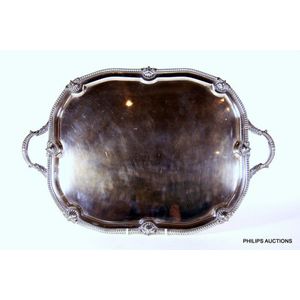Large Mappin & Webb Silver Plate Tray
You must be a subscriber, and be logged in to view price and dealer details.
Subscribe Now to view actual auction price for this item
When you subscribe, you have the option of setting the currency in which to display prices to $Au, $US, $NZ or Stg.
- Acanthus - A stylized leaf motif, one of the primary decorative elements of classical Greek and Roman architecture, derived from the genus of flowering plants in the family Acanthaceae, native to tropical and subtropical regions of the Mediterranean area. It is a common element in classical Greek and Roman design, and is often seen in Corinthian and Composite order columns and used as a decorative element in English, European and Australian furniture, particularly on the curve of a leg, and as decoration for a corbel.
- Gadrooning - A series of lobes usually as a border. In furniture gadrooning is found as carved decoration around the edges of table tops in the Chippendale and Jacobean style furniture. Gadrooning is also found as decoration on the rims of silver and ceramics.
- Scallop / Shell Motif - The shell motif has been used in furniture and decorative arts for centuries. In ancient Greece and Rome, shells were often used as decorative elements on furniture and in mosaics. The scallop or cockleshell are the most commonly used. During the Renaissance, the shell motif became popular in furniture and architecture, as the ornate decoration was seen as a symbol of wealth and luxury. In the 18th century, the Rococo style of furniture and decorative arts featured an abundance of shell motifs, and it was used by Thomas Chippendale and as a feature on Queen Anne style cabriole legs. In the 19th century, the shell motif was incorporated into Victorian furniture and decorative items, and often a representation of the the conch shell was inlaid into furniture.
This item has been included into following indexes:
Visually similar items

A fine large French .950 silver tray, mid 19th century, with Minerva 1 standard and maker's mark for Jean Francois Veyrat, an oval tray with serpentine reeded edges with engraved floral initials to the rim; hallmarked underside, silver weight 1109gr. Lengt

George VI sterling silver salver, Sheffield 1941, makers Harrison Brothers and Howson. With engraved dedication and several unidentified engraved signatures, dated 1944. Quad-footed. Diameter 25 cm weight 610grams

A sterling silver presentation salver, 1921 Sheffield, with maker's mark for Walker & Hall, with a pie crust border and engraved to Edmund Hill Esq, General Secretary of the Federation of British Industries 1916-1921, raised on three whorl feet; hallmarked

A fine sterling silver salver 1935/6 Birmingham, with maker's mark for Collingwood & Sons Ltd. The salver with a pie crust edge raised on three small curvaceous feet, bearing a 1938 inscription to the dish to P.F. Ward Esq, Superintendent Prudential Assura
